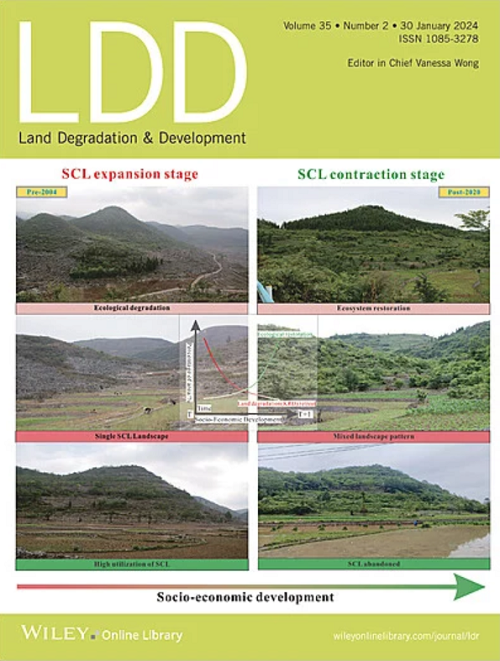基于长期Landsat影像的煤粮复合区耕地破坏复垦自动检测
IF 3.6
2区 农林科学
Q2 ENVIRONMENTAL SCIENCES
引用次数: 0
摘要
中国东部平原是众多“煤粮复合区”的所在地,在那里,大规模的地下煤矿开采导致了广泛的地面沉降和农田破坏,深刻影响了区域生态环境、农业生产和粮食安全。本研究提出了一种农田破坏与复垦的自动检测方法。选取长期Landsat影像的归一化植被指数(NDVI)作为主要因子。首先,通过从矿区提取大量的NDVI样本,确定了因采矿干扰而导致耕地破坏的阈值。基于耕地干扰机制,构建了不同类型和尺度的NDVI变化模板。随后,采用Fast Dynamic Time Warping算法对时间序列曲线进行匹配,识别干扰类型,并制定了耕地干扰年份和程度的检测规则。最后,建立受干扰农田的斑块指标,并利用随机森林模型消除人为建设引起的干扰噪声。将该方法应用于淮北煤炭基地,对1987 - 2022年采矿活动造成的耕地破坏和复垦进行了制图,总体精度分别为0.85和0.81。研究结果显示,在监测期间,因采矿活动而破坏的耕地总面积达10179.71公顷。1987 - 2005年耕地破坏面积较小,占整个时期的27.51%。2006 - 2018年,耕地破坏面积显著增加,累计6102.01公顷,占同期耕地破坏面积的59.94%。2018年以后,耕地破坏面积迅速减少并趋于稳定。大致于1995年开始填海,填海总面积2734.83公顷,填海率26.86%。该研究为矿山开采环境影响监测和生态恢复效果评价提供了重要参考。本文章由计算机程序翻译,如有差异,请以英文原文为准。
Automatic Detection for Cropland Destruction and Reclamation in Coal‐Grain Composite Region Using Long‐Term Landsat Imagery
The eastern plains of China are home to numerous “coal‐grain composite regions,” where extensive underground coal mining has led to widespread land subsidence and cropland destruction, profoundly affecting regional ecological environments, agricultural production, and food security. This study proposes an automatic method for detecting cropland destruction and reclamation. The Normalized Difference Vegetation Index (NDVI) derived from long‐term Landsat imagery was selected as the primary factor. First, by extracting a substantial number of NDVI samples from the mining areas, the threshold for cropland destruction due to mining disturbances was determined. Various types and scales of NDVI change templates were constructed based on the mechanisms of cropland disturbance. Subsequently, the Fast Dynamic Time Warping algorithm was employed to match the time‐series curves and identify disturbance types, along with formulating detection rule for the year and magnitude of the cropland disturbance. Finally, patch indicators for disturbed croplands were established, and a random forest model was utilized to eliminate the disturbance noise induced by anthropogenic construction. The proposed method was applied to the Huaibei coal base, mapping cropland destruction and reclamation due to mining activities from 1987 to 2022, with overall accuracies of 0.85 and 0.81, respectively. This study revealed that the total area of cropland destroyed by mining activities amounted to 10179.71 ha during the monitoring period. From 1987 to 2005, the area of cropland destruction was small, accounting for 27.51% of the entire period. Between 2006 and 2018, the area of cropland destruction significantly increased, totaling 6102.01 ha and accounting for 59.94% of the entire period. The area of cropland destruction rapidly decreased and stabilized after 2018. Reclamation efforts began roughly in 1995, achieving a total reclaimed area of 2734.83 ha, with a reclamation rate of 26.86%. This study provides a crucial reference for monitoring the environmental impacts of mining and assessing the effectiveness of ecological restoration.
求助全文
通过发布文献求助,成功后即可免费获取论文全文。
去求助
来源期刊

Land Degradation & Development
农林科学-环境科学
CiteScore
7.70
自引率
8.50%
发文量
379
审稿时长
5.5 months
期刊介绍:
Land Degradation & Development is an international journal which seeks to promote rational study of the recognition, monitoring, control and rehabilitation of degradation in terrestrial environments. The journal focuses on:
- what land degradation is;
- what causes land degradation;
- the impacts of land degradation
- the scale of land degradation;
- the history, current status or future trends of land degradation;
- avoidance, mitigation and control of land degradation;
- remedial actions to rehabilitate or restore degraded land;
- sustainable land management.
 求助内容:
求助内容: 应助结果提醒方式:
应助结果提醒方式:


